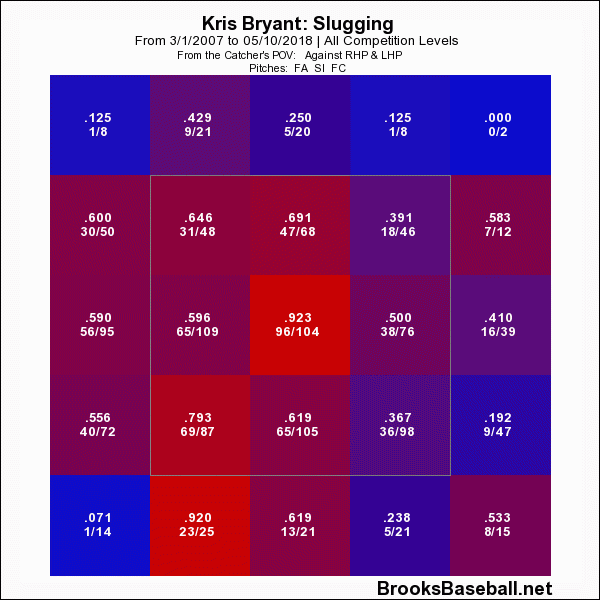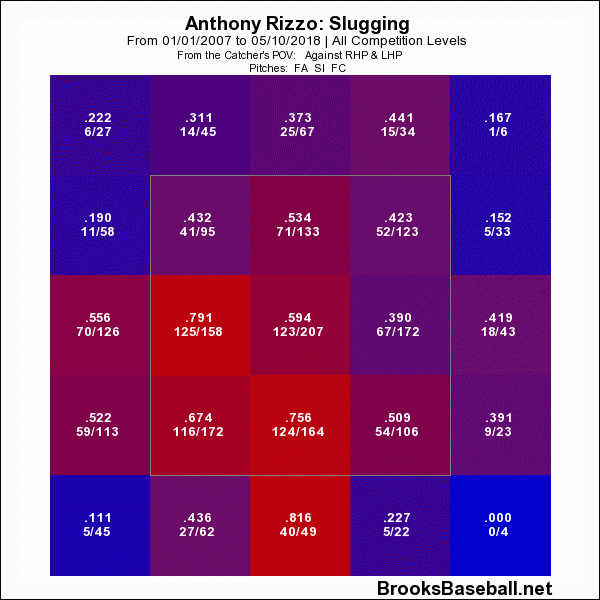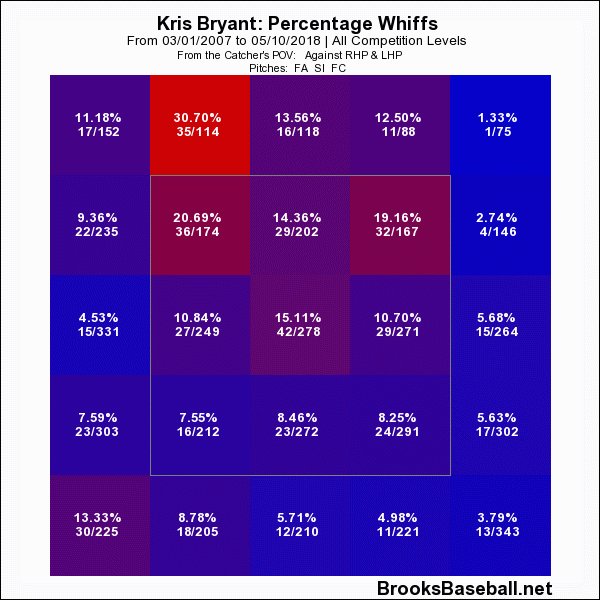I’ve seen two Cubs stars hit in the head with fastballs. The first was Salomon Torres heater that shattered Sammy Sosa’s helmet on April 20, 2003 as I stared at my TV in mute horror was. In some respects, this the beginning of the end: he’d scuffle for the next several weeks and be suspended eight games after being ejected on June 4 for using a corked bat. Don’t get me wrong. 2003 was still a magical season, but memory has a way of constructing narratives we couldn’t see at the time. We all know how the story ends, in late 2004, Sosa’s clubhouse boombox in pieces, like his helmet. Stars in their courses.
So I was worried, for reasons beyond medical, when a German Marquez fastball sent Kris Bryant’s helmet spinning around his head and he proceeded to go 0-for-his first 9 at-bats after returning on April 28.
Of course, if you’ve watched this week’s games, you know, like I do, that everything’s fine. But just to confirm for you:
March 29 to April 22 (90 PA): .319/.467/.536/175 wRC+ (.217 ISO, 14.4 BB%/13.3 K%)
April 28 to May 9 (49 PA): .250/.327/.659/162 wRC+ (.409 ISO, 8.2 BB%/22.4 K%)
Yes, he’s struck out more and walked less since his return, though these numbers look more like his career line than what he was doing to start the season. His BABIP looks low (.241). And I’ll concede: a 162 wRC+ is not as high as a 175 wRC+ (not that I’d ever complain about it). But look at that ISO. It’s telling you what your eyes already did. He’s punishing baseballs right now.
Still, what about pitches heading toward him? Is he flinching? Letting them pass by? Swinging through them? Or is he, in a fascinating Baseball Tonight interview with Alex Rodriguez, daring pitchers to give him fastballs in?
The angle of the video is a little imprecise, and A-Rod seems a little more interested in locating the precise position of this pitch than Bryant is, and Brooks Baseball doesn’t let you filter by “thigh high,” so let’s just call it inner-third, lower-third.
Now, this is Kris Bryant. He’s a smart, self-aware, studious hitter. You’d expect him to know his spots. Still, there’s always the possibility that he’s trying be too interesting with his answer, or that he’s fantasizing about a pitch he once crushed or wished he’d crushed. Besides, he says pitchers think there’s a hole in his swing lower-in. So is there? Let’s take a look.
Well. I’d call that succeeding in exactly the spot he was talking about, wouldn’t you? But the sample size is too small to usefully break down this chart for pitch type in 2018. So let’s take a step back and look at the entirety of his big league career, filtering for hard pitches (fastballs, cutters, sinkers):
That looks even better.
I know, I know. Confirming that an MVP-caliber slugger with an upper-cut swing in the midst of the fly-ball revolution hits low, hard pitches well is hardly surprising. But the horizontal location wasn’t a given. Here’s Anthony Rizzo, for his career, on hard pitches:
He’s not bad lower-in! But it’s definitely not his spot. That’s one of the reasons he stands so close to the plate.
One more heat map: bear with me. We’ve seen that Bryant does damage when he makes contact on pitches low and in. But maybe his hypothetical pitchers are onto something. Maybe there’s even a slightly elevated chance that he’ll whiff if they put a fastball there:
Or maybe there isn’t. So it’s not just that Kris Bryant does more damage than usual when he makes contact on a pitch lower-in, he also makes more contact than usual. And that’s what distinguishes the pitch lower-in from the pitch dead center, on which he does a more damage but misses twice as often.
Kris Bryant knows his spot. Pitchers, you’ve been warned.
Okay, okay—one more heat map! A bonus heat map! Remember my emotion-driven concern that Bryant won’t be able to handle high fastballs, even temporarily? Well, look at what he’s done to hard stuff up and in, but still in the zone, since his return on April 28:
Maybe it’s the fastball high and tight that needs to be afraid of Kris Bryant right now.
Lead photo courtesy Patrick Gorski—USA Today Sports





